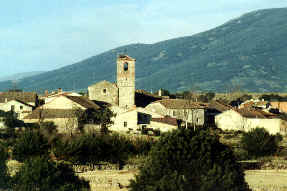
Spain
in the Fall
A
Marvelous Country for Castles,
Cuisine, and Culture
and Some Great Birding
With some good Fall Migration
Also, during this tour, an
Annular Solar Eclipse
(tour:
FON/SP-4 '05)
September 22 - October 3, 2005
2005
will be our 13th year for birding tours in Spain!
(We've done 23 tours there thus far.)

The leader of the tours will be
Armas Hill,
who has birded in Spain numerous times.
Spain
Bird List
Europe
Bird List
Itineraries for
FON/SP-14:
Price follows.
(Above tour dates include day of departure from North America on an overnight flight to Spain.)
Thu, Sep. 22: Departure from North America on an overnight flight to Spain.
Fri, Sep. 23 Arrival in Madrid. Our first Spanish birding in the forested area of Casa de Campo, west of the city. That large park is a good place for an assortment of birds: various woodpeckers, tits, warblers, the Nightingale, and Hoopoe. Travel will then follow west toward the region of Extremadura, with an overnight in Oropesa, an old town atop a hill. The overnight is actually in a castle, where Lesser Kestrels, White Storks, and other birds nest during the day. Barn Owl at night. Nesting will be over, but the setting, and birds, will still be there.
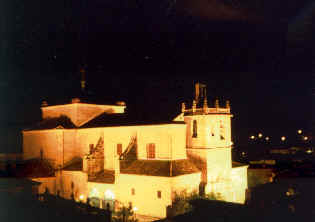
Sat, Sep. 24 A full day of birding in the region of Extremadura - an area particularly good for raptors ,including eagles, kites, and Old World Vultures. And: storks, bee-eaters, hoopoes, rollers, and more. At dusk and after dark: various owls, including the Eagle Owl. Another specialty of the region: the Bustards, both Great and Little. During our past tours, we had stupendous looks at both species displaying. Visited will be the outstanding Monfrague Natural Park. Overnight this, and the next night, at a small village near Monfrague.
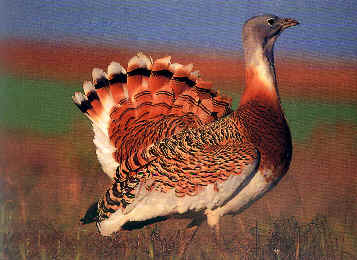
As many as 34 Great Bustards
have been seen
during one FONT Spain Tour.
Sun, Sep. 25 More excellent birding in the Extremadura region. Additional specialties of the area include: the Black Stork, the rare Eurasian Black Vulture, and the Spanish Imperial Eagle. We'll be watching raptors from a tower atop a ridge where a castle was built back in the 11th Century by the Berbers. "Monfrague" is a name from the Romans, from that time, referring to an inhospitable terrain. Today, the place is one of the best in Europe for wildlife.
Mon, Sep. 26 A final day of birding in the Extremadura region. Late-day travel north to the beautifully forested Gredos Mountains (the Sierra de Gredos). Overnight in the village of Navarredonda.
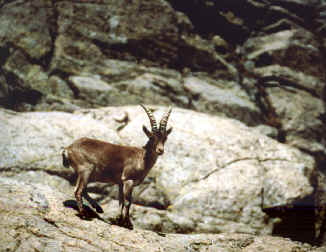
A Spanish Ibex in the Gredos
Mountains.
Tue, Sep. 27:
A full-day of birding in the Sierra de Gredos, both above and below the
timberline. Among the birds to be sought will be the Alpine Accentor, White-bellied Dipper, and Rufous-tailed Rock-Thrush.
During our recent tours, in this region: Ortolan Buntings in the
bushes, and Citril Finches in the coniferous forest. The Sierra
de Gredos can be great for raptors soaring in the sky. The
Spanish Ibex occurs on the mountainside rocks. Overnight, again, in the village of
Navarredonda.
Wed, Sep.
28
After
some morning birding in the area of the Gredos Mountains, travel north toward
the city of Zaragoza. There will be birding along the way. Overnight near
Zaragoza, to be in position for our early morning visit, the next day, to the
region of the Spanish Steppes, for some specialty birds.
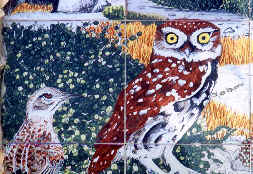
The DuPont's Lark &
Little Owl
are among the birds of the dry "Spanish Steppes".
Thu, Sep. 29 Early morning birding in the "Spanish Steppes", a dry region with such bird specialties as: Pin-tailed and Black-bellied Sandgrouse, Stone-Curlew, Spectacled Warbler, and larks - as many as 6 species of larks in one area. Among them, the Dupont's Lark is a possibility (although it's more easily found earlier in the year.) Also in this region, in the Fall, we've seen migrating flock or two of Eurasian Dotterels. After a visit to Belchite, a town destroyed during the Spanish Civil War, and usually a good birding spot, travel toward the very-birdy Ebro Delta, along the Mediterranean, where we'll have two full days of birding in various habitats, at a time when numerous migrants will be passing through. Overnight not far from the Ebro Delta.
Fri & Sat, Sep 30 & Oct 1 Two full-days of birding in the fascinating Ebro River Delta, an area that's very rich with birdlife. Among the notable birds there: herons of various species (including Squacco and Purple); terns of various species (including Whiskered, Gull-billed, Little, and Sandwich - also, with some luck: the Lesser Crested). Gulls include Audouin's and Slender-billed Gulls. There's an assortment of waders (or shorebirds) including avocets and stilts; flamingos; and more - ranging from the Red-crested Pochard to some Old World warblers. Shorebirds, and other birds too, should be passing through in numbers as they migrate south. These 2 overnights again, near the Ebro Delta.
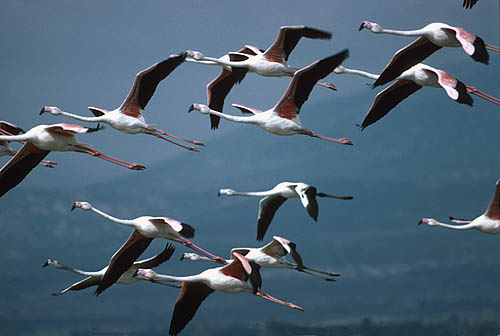
Flamingos
at the Ebro Delta
Sun, Oct 2 After a final morning's
birding in the Ebro Delta area, travel to Madrid. Overnight, there, not far from
the airport.
Mon, Oct 3
This morning, in usually
(and hopefully) sunny Madrid, there will be in the sky overhead an Annular
Eclipse of the Sun. It will start about 20 minutes before 8 o'clock,
and will end about 20 minutes after 10 o'clock. In between, there will be a
period with a ring-like sun lasting for 4 minutes & 11 seconds.
Later, this day, in the early afternoon, it will be time for the departure from
Spain. Those returning to North America will arrive there the same day, in the
afternoon.
![]()
Tour price, in U.S. dollars, per person, based upon double occupancy: $1,995
Single supplement: $245
Price includes: All overnight accommodations and land transportation within Spain. Most meals (breakfasts and lunches).
Price does not includ: Dinners. Drinks and other items of a personal nature. Flights to/from Spain.
A deposit of $400 would be required to register for this tour.
![]()
Spain
has more birds and other wildlife
than
any other Western European country
Particularly
more Raptors:
5 species of
Eagles; 4 species of Old World Vultures; 3 species of Kites;
2 species of
Harriers; and 5 species of Falcons (including 2 Kestrels), plus:
Accipiters and Buteos
Also more Owls than elsewhere in Europe (notably more Eagle Owls)
And other
notable Large Birds:
2 species of
Bustards; 2 species of Storks, Capercaille, and Black Woodpecker
And a number
of distinctive and colorful birds as well:
Bee-eater,
Hoopoe, Roller, Golden Oriole, the Woodchat and other Shrikes,
the rare
Wallcreeper, 2 species of Nightjars; 2 species of Sandgrouse; a
least 2 species of Swifts;
2 species of
Cuckoos; 2 species of Choughs; 2 species of Magpies;
the Stone
Curlew; the graceful Pratincole;
the
white-spotted form of the Bluethroat; other Thrushes of note,
and numerous
Larks and Wheatears of various species.
